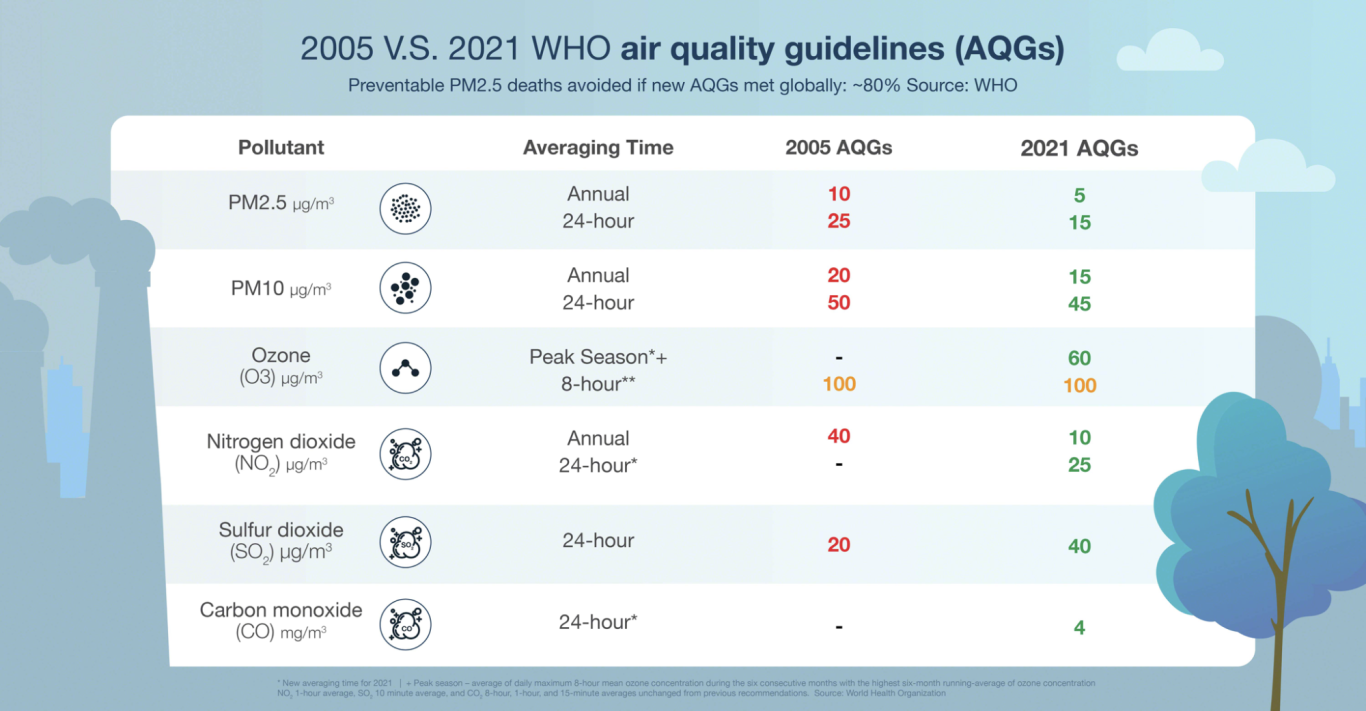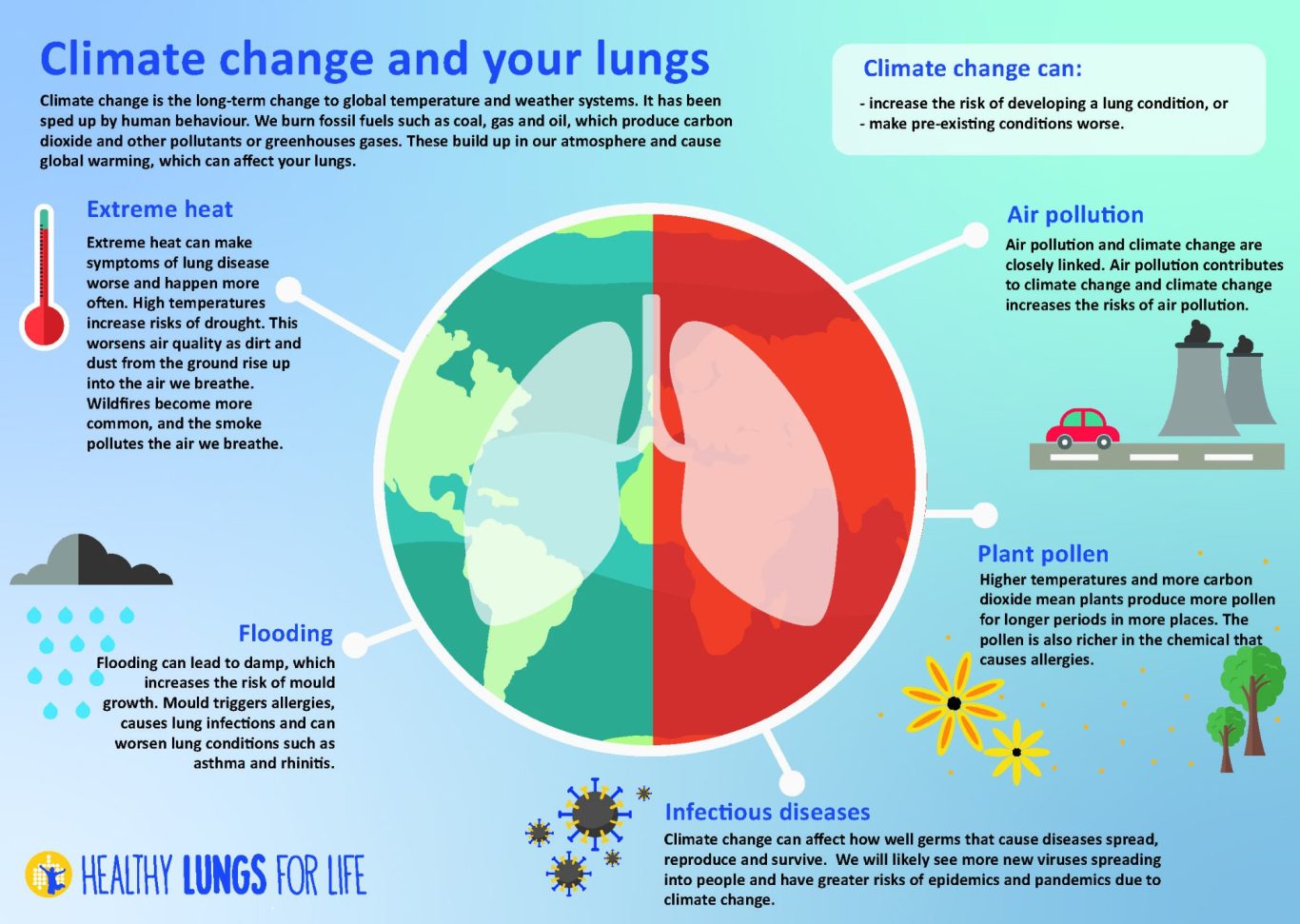.
"Schools should be safe places of learning, not places where students are at risk of health hazards."
Dr Maria Neira, Director at the World Health Organisaton
Why Does Air Quality Matter?
Indoor air quality (IAQ) refers to the condition of the air within buildings, such as schools, and its impact on the health and well-being of those occupying them. Air pollution occurs when harmful pollutants contaminate the air, negatively affecting our health, ecosystems, and climate.
Air pollution can affect every organ in the body. It is the leading environmental health risk factor for children whose developing organs and immune systems are particularly vulnerable to harmful pollutants. Other groups that are more susceptible to harm include pregnant women, those living with allergies, heart or lung conditions like asthma and people with suppressed immune systems (due to chemotherapy, disease or radiation).
Most of us understand that outdoor air pollution can impact health; however, we spend 90% of our time indoors. Ignoring indoor air quality means ignoring the place where people breathe the most. Recognising the importance of clean indoor air as far back as 1860, Florence Nightingale emphasised the critical role of ventilation and clean air in her work "Notes on Nursing: What it is, What it is Not". Nightingale's insights laid the foundation for modern nursing practices.
"The very first canon of nursing, the first and the greatest, is this: to keep the air the patient breathes as pure as the external air, in quantity and quality."
Florence Nightingale (1860)
In recent years, the COVID-19 pandemic reignited discussions about indoor air quality, drawing attention from a wider audience. As concerns about children's health grew, parents and caregivers became increasingly aware of the importance of maintaining clean air inside educational settings. Questions arose about how to protect both children and teachers in these environments. In response, scientists worked to inform and educate the public, and as a result, a new drive for clean indoor air in public buildings has begun.
What Are Outdoor Air Pollutants?

Studies have shown that air pollution can impact health even at lower concentrations than previously thought. In 2021, the World Health Organization (WHO) updated its air quality guidelines to reflect new scientific findings on the health effects of air pollution. The UK has not yet committed to meeting the 2021 WHO Air Quality Guidelines, designed to protect public health.
Key outdoor pollutants include:
Particulate matter: An umbrella term for the microscopic particles suspended in air. They are defined by their diameter to regulate air quality. PM2.5 particles are so small they can penetrate deep into lungs enter the bloodstream, and be transported to every organ in the body. Sources of particulate matter are both natural and man-made and produced both indoors and outside.
Ozone: Ground-level ozone is not emitted directly into the air but is created by chemical reactions between volatile organic compounds and nitrogen oxides in the presence of sunlight.
Nitrogen Oxides: Gasses produced by power generation and domestic heating, contributing to acid rain and smog formation.
Sulphur Dioxide: Created by burning fossil fuels like coal and oil, it contributes to acid rain.
Carbon Monoxide: Produced by incomplete combustion of fuels like wood, charcoal, and gasoline.
Volatile Organic Compounds: Gasses emitted from paints, cleaning products, and building materials.
What Air Pollutants Can Be Found Indoors?
Polluted outdoor air doesn’t stop at our doorsteps—it enters buildings through cracks, windows, and even on clothing. Outdoor air pollutants enter buildings through windows and cracks in concrete as well as on shoes and clothing. Pollutants are also generated inside buildings so it is unsurprising that Indoor air pollution can be five to 100 times worse than outdoor pollution. Common indoor pollutants include:
Pollen: Released by plants.
Mould and Fungus: Resulting from damp, poorly ventilated buildings.
Dust: Includes particles like clothing fibers, pet dander, wind-blown soil and dust mites.
Smoke: Most particulate emissions in the UK come from burning wood and coal in domestic fires and stoves and fireplaces.
Viruses and Bacteria: Spread through the air when people breathe, and can linger for hours.
Volatile Organic Compounds (VOCs): Emitted from indoor products like paints, cleaning supplies, and furnishings.
Carbon Dioxide (CO2): Produced by breathing and stoves.
Carbon Monoxide (CO): Emitted by combustion appliances like stoves and heaters.
Nitrogen Dioxide (NO2): From road traffic and coal-fired power plants.
Radon: A radioactive gas that seeps from the ground into buildings.
Formaldehyde: Emitted from building materials and household products
"When it is safe enough for the most vulnerable, it is safe enough for everyone."
Lara Wong, Founder, Clinically Vulnerable Families
Indoor air pollution is an invisible threat that must be responded to with urgency because the effects can be subtle starting with short-term health problems for students and staff building to reduced attendance, test scores and chronic disease.

Climate Change and Indoor Air Quality
Air pollution and climate change are closely interconnected, and both have significant impacts on nature.
Common Sources
Many sources of air pollution, such as burning fossil fuels (coal, oil, and gas), also release greenhouse gases like carbon dioxide and methane. These pollutants contribute to both air pollution and climate change.
Health and Ecosystems
Pollutants such as particulate matter and ground-level ozone are known to cause respiratory and cardiovascular diseases They also harm plants, animals, and entire ecosystems, reducing biodiversity and disrupting natural habitats.
Climate Impact
Certain air pollutants, like black carbon (a component of fine particulate matter), absorb sunlight and warm the atmosphere. When they land on snow and ice, they reduce reflectivity, accelerating the melting of glaciers and contributing to global warming.
Feedback Loops
Climate change can exacerbate air pollution. For example, higher temperatures can increase the formation of ground-level ozone, a harmful pollutant. Additionally, climate change can lead to more wildfires, which release large amounts of particulate matter and other pollutants into the air.
Mitigation Strategies
Addressing air pollution can also help mitigate climate change. Reducing emissions from vehicles, industries, and energy production not only improves air quality but also decreases greenhouse gas emissions, benefiting both human health and the environment.
By tackling air pollution, we can make significant strides in combating climate change and protecting nature so it’s a win for both public health and the environment.

The Clean Air (Human Rights) Bill
The Safe Air Schools Foundation supports the Clean Air Bill.
If successful, this Bill would make breathing clean air a human right and require the government to establish a commission that would oversee government action on air pollutants.
The Bill also amends the Environment Act 2021 to incorporate missing elements such as air quality target limits in line with WHO guidelines. This is desperately needed considering most schools in the UK are in areas above the WHO recommended levels. It is recommended that the commission pay particular regard to the needs of especially sensitive groups such as children in setting their target limits, including indoors and on public transport.
Clean Air Bill Summary
- To make provision for reducing indoor and outdoor air pollution, including greenhouse gases
- To set minimum standards for air quality in workplaces, homes and public spaces
- To require the monitoring of air quality
- To require the Secretary of State to publish a strategy for reducing air pollution, including setting targets and measures for air quality, and to report to Parliament annually on the implementation of that strategy
- To give powers to the Office for Environmental Protection to enforce legislation relating to air quality and the reduction of greenhouse gas emissions
- To make provisions to reduce pollution from vehicles
- To place a duty on the Secretary of State to encourage and facilitate forms of active travel and to publish a strategy for reducing emissions from transport

Dr Ben King (BSc) Hons PhD PGCE
UN-Accredited Climate Change Teacher:
"As the world continues to get warmer, there will be an increased likelihood of extreme weather events, including heatwaves. During these periods of high pressure, airflow is reduced and air pollutants such as dust, viruses and pollen will build up indoors.
Climate change will also bring more extreme storminess. On windier days, our indoor air can become stagnant, as people tend to close more windows; mould spores can then become an additional concern, alongside the enhanced spread of airborne viruses.
Indoor air quality needs addressing in a more holistic way, rather than simply relying on individuals opening windows and doors to enhance ventilation; this is of particular concern in places with high concentrations of people (e.g. schools) or where people are at their most vulnerable (e.g. hospitals and care homes)."







